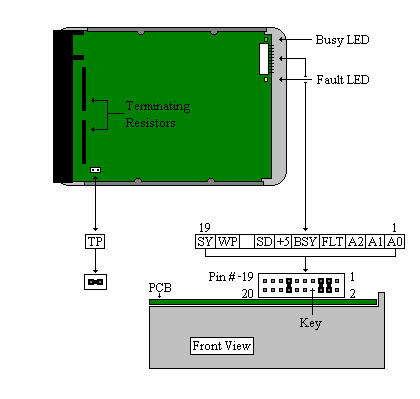WARNING: Drive jumpers may not be same as below
Capella VP32210S
Jumper Name Description
TP - Termination power
Pins 1-2 A0 SCSI ID address selection
Pins 3-4 A1
Pins 5-6 A2
Pin 7 FLT Out Fault display LED option
Pin 9 BSY Out Busy display LED option
Pin 11 +5VDC LED anode connection
Pin 13 SD Spin delay option
Pin 15 - Reserved - not used
Pin 17 WP Write Protect option
Pin 19 SY Spindle Sync.
Table 1
Termination Enable
One of the requirements of the SCSI bus is that it be properly terminated. If more than one SCSI device is connected to the host, only the last device must be terminated. The Capella disk drive utilizes two (2) 10 pin resistor packs to enable SCSI bus termination.
At the factory, Quantum configures the Capella VP32110S hard disk drive with termination enabled; that is, with both resistor packs installed . To disable termination, remove the two resistor packs from the drive. [Refer to figure 1 for location.]
Termination Power (TP)
It is recommended that the drive be configured to provide Termination Power to the SCSI bus. This ensures that there is sufficient power along the entire SCSI bus. The Termination Power (TP) jumper, when installed, enables termination power to be provided by the disk drive.
At the factory, Quantum configures the Capella VP32110S hard disk drive with termination power enabled; that is, with a jumper installed across the termination power pins on jumper block J5. To disable termination power, remove the jumper from the pins at location J5. [Refer to figure 1 for jumper location.]
SCSI-Bus Device Identification
Used in combination, the jumper settings across reference pins of the Option Connector J3 determine the Capella VP32110S hard disk drive's SCSI-bus device I.D.
To assign a different SCSI ID, change the jumper settings as shown in Table 2.
Pins 5-6 Pins 3-4 Pins 1-2 SCSI ID OFF OFF OFF 0 OFF OFF ON 1 OFF ON OFF 2 OFF ON ON 3 ON OFF OFF 4 ON OFF ON 5 ON ON OFF 6 ON ON ON 7 Table 2
Spin Delay (SD)
With the Spin Delay jumper installed, across pins 14-15 of Option Connector J-3, the drive will start power up sequence immediately when power is applied. With the Spin Delay jumper removed the drive will power up when a START/STOP command is issued by the host adapter.
By default, Quantum configures the drive with a jumper installed across pins 14-15.
Spindle Sync (SY)
Atlas disk drives support synchronized spindle operation. Master or slave synchronized operation is set through a SCSI Mode Select Page.
When the drive operates as a Master drive, it generates a spindle synchronization reference signal, SPINDL_SYNC_REF L. When operating as a slave, the drive synchronizes its spindle according to the SPINDL_SYNC_REF L input reference. The drive always maintains local speed regulation when no reference signal is applied.
Pin 19, of Option Connector J-3, is provided to facilitate installations where a 2-pin connector for SPINDL_SYNC_REF L will be used. The ground return is pin 20, although pins 2, 4, or 6 can be used for ground return.
Write Protect (WP)
To enable write protection on the drive, install the referenced jumper across pin pair 17-18 of Option Connector J-3. To disable write protection from the drive, remove the jumper from pin pair 17-18.
Remote LED Status Display
Busy and Fault status for Capella VP32110S disk drives can be monitored remotely by connecting a remote Busy and a remote Fault display LED to the drive's Option Connector J-3.
Busy status is monitored remotely by connecting the cathode side of the remote Busy LED to the BSY_OUT L pin. The anode side of the LED connects to the +5 VDC OUT pin.
Fault status is monitored remotely by connecting the cathode side of the remote Fault LED to the FLT_OUT L pin. The anode side of the LED connects to the +5 VDC OUT pin.
